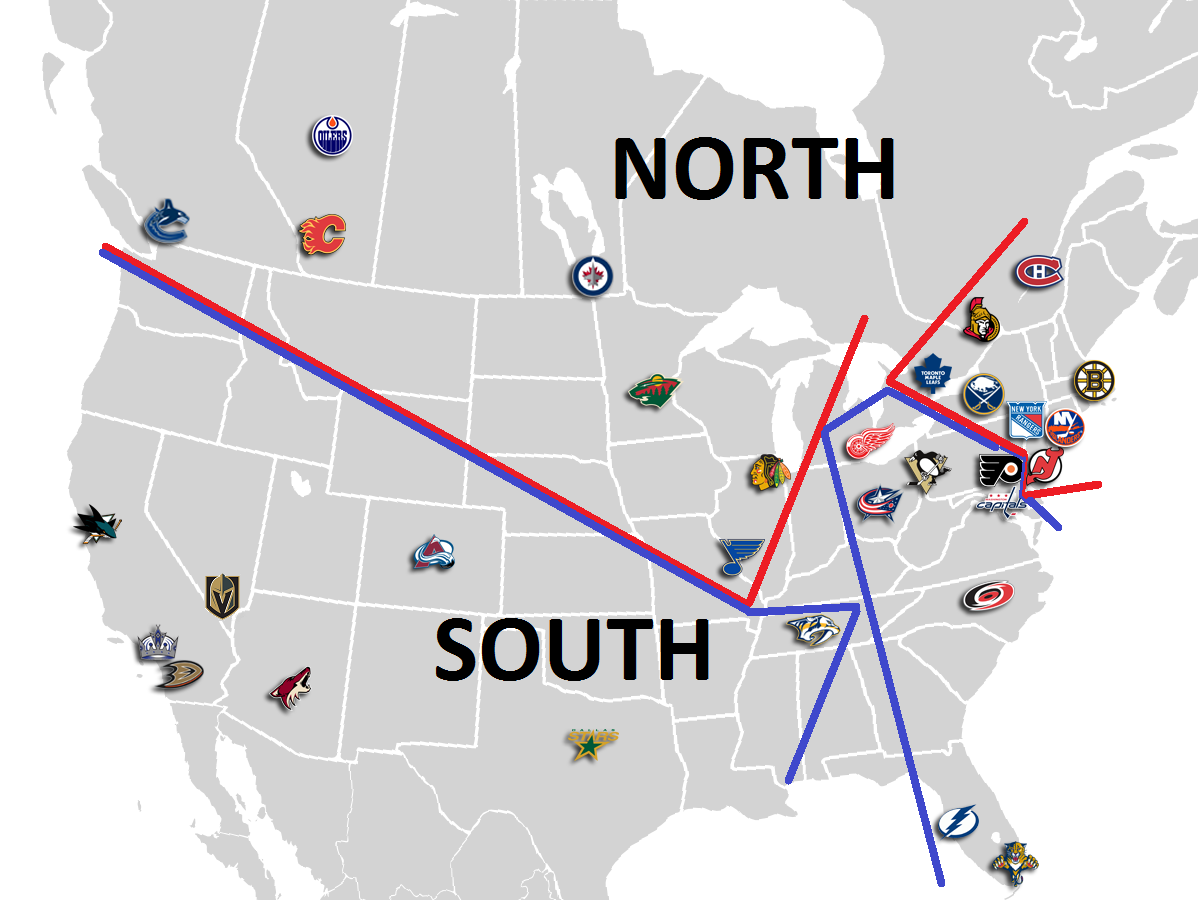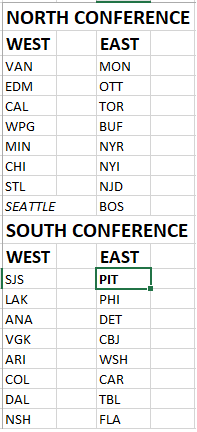We’ve reached the dog days of the NHL off-season where we are equally as far away from the captain hoisting the Cup as we are far away from watching another banner going up. Sure, there are minor free agent signings and preliminary Olympic news but nothing major is really happening.
Therefore, get your hockey fix by making Pensblog your startup page. Also, listen to Pensblog’s Pat & Leah Have a Hockey Podcast.
To bridge the gap to preseason, here is the first of a few creative-thinking/outside-the-box ideas on how the NHL could improve.
NHL CONFERENCES, DIVISIONS, SCHEDULING, PLAYOFF FORMAT
The most recent realignment of teams, divisions and scheduling occurred in 2013-14.
2000-01 to 2012-13: 2 conferences/3 divisions/5 teams per division
Inter-conference schedule: 18 total games – 1 home game & 1 away game vs. 9 of 15 opposite conference teams
2013-14 to 2016-17: 2 conferences/2 divisions/8 teams in each Eastern division & 7 teams in each Western division
Inter-conference schedule: 32 (West) or 28 (East) total games – 1 home game & 1 away game vs. each opposite conference team
The addition of Vegas Golden Knights this autumn will not change things significantly. They join the Pacific Division meaning all except the Central Division of the Western Conference will have 8 teams. Each East team will now play 30 total games against the West.
Realignment rectified the geographically-incorrect placement of certain teams in the “wrong” conference: Detroit and Columbus in the West and Winnipeg in the East. However, the NHL still has an imbalance in terms of the larger amount of mileage Western Conference teams log during a season relative to the more densely-populated Eastern Conference teams. Also, the number of inter-conference games for each team increased significantly from 18 to 30 (or 32).
Here are the 31 NHL teams distributed by time zones:
Pacific Mountain Central East
West Conf 5 4 6 0
East Conf 0 0 0 16
What do time zones have to do with NHL alignments and scheduling? Recent sleep science research showed that in a five-season sample, the road winning percentage of Eastern teams playing in Western cities is lower than the road winning percentage of Western teams playing in Eastern cities in the NBA, NHL and NFL. There seems to be a “circadian disadvantage” from travelling east to west and playing night games. Players’ minds and bodies cannot adapt quickly enough to a three time zone change. For example, if the Penguins fly out from Pittsburgh to San Jose, players perceive a 7 p.m. to 10 p.m. Pacific game as biologically occurring between 10 p.m. and 1 a.m. – a time of day when people become naturally fatigued and should go to sleep.
The researchers cited previous studies that found peak performance occurs during the biological time window of 3 p.m. to 6 p.m. In other words, in the opposite scenario, when the Sharks fly into Pittsburgh for their first stop on an Eastern road trip, San Jose players would “perceive” a 7 p.m. to 10 p.m. game as taking place from 4 p.m. to 7 p.m., roughly within the optimal window and thus giving them a circadian advantage on the Penguins.
Here are the composite inter-conference points percentages from the 8 most recent completed NHL regular seasons irrespective of home/road splits.
East v. West West v. East
2017 .584 .533
2016 .556 .545
2015 .537 .578
2014 .516 .607
2013 (no inter-conference games)
2012 .565 .580
2011 .539 .600
2010 .494 .626
2009 .530 .570
There does seem to be a correlation to the sleep researchers’ conclusions in this small sample, though the East has prevailed in inter-conference competition in the past two seasons.
To reduce the East – West bias of travel-related fatigue, there are really only two choices: 1) contract the NHL by eliminating all nine Pacific and Mountain time zone teams, or 2) distribute the burden of travel-related fatigue across all 31 teams. Financially, choice #2 is more feasible. What if instead of the historic focus on East and West, the NHL considered a completely different format for allocating its teams?
NORTH – SOUTH CONFERENCE FORMAT

Think of the general framework of Major League Baseball. Both the American League (red lines) and National League (blue) each have East, Central and West Divisions featuring teams that are spread similarly across the nation’s time zones. In October, neither team playing in the World Series can claim that the other had a significantly more comfortable travel schedule during the regular season.
For hockey, to mitigate the current travel bias, how about transforming the NHL into a North – South alignment? In this scenario, every team shares the cost and punishment of cross-continent travel equally.
In the low-tech dynamic double-map below (click it to enlarge), the first map shows the present NHL divisions. Clubs from the Pacific and Central Divisions of the Western Conference are inside the red lines. For the Eastern Conference, the green boxes enclose the Atlantic Division clubs while the blue box groups together the Metropolitan Division clubs.
The second map shows the proposed two divisions of a North Conference (red brackets) and two divisions of a South Conference (blue brackets). Each conference’s divisions try to take into account existing traditional rivalries, time zone fairness and a balanced number of teams in the two conferences. (Yes, there are 31 teams now but in the next five years, assuredly another expansion team and realignment/relocation will yield perfectly even 16 team conferences.)
At last, travel miles are spread out more fairly across the NHL. Sure, eastern-based owners will grumble about increased travel costs and western teams’ players will grumble about increased fatigue. However, fair is fair. And half the fun would be seeing Jeremy Jacobs flip out about increased expenses. Note the new allocation of teams by time zones in this North and South format.
CURRENT Pacific Mountain Central East
West Conf 5 4 6 0
East Conf 0 0 0 16
NEW Pacific Mountain Central East
North Conf 2 2 4 8
South Conf 4 2 2 8
- All seven Canadian teams are grouped in one conference
- Each conference features an equal number (8) of Eastern time zone-based clubs
- The triple metro New York City, Boston – Montreal, Toronto – Montreal and Battle of Ontario rivalries are preserved
- Flyers – Penguins and Capitals – Penguins rivalries are preserved
- The state of Florida is no longer treated like an island by the NHL
SCHEDULING
For simplicity, let’s assume Seattle gains an expansion team, slotted in the North Conference West Division yielding 32 NHL teams in 4 x 8 team divisions.
Own Division (28 total games, 14 home + 14 away)
- 7 teams x (2 home + 2 away)
Own Conference, Other Division (24 total games, 12 home + 12 away)
- 4 teams x (2 home + 1 away)
- 4 teams x (1 home + 2 away)
*alternate group of 4 teams each season to balance home ice advantage/disadvantage
Inter-Conference (32 total games, 16 home + 16 away)
- 16 teams x (1 home + 1 away)
GRAND TOTAL = 84 total games, 42 home + 42 away
We return to the 84-game schedule that was used briefly in the early 1990s. Start the season one week earlier to avoid awarding the Cup after the first day of summer. There are other scheduling formats that would maintain the current 82-game calendar but logic and simplicity should prevail. Having at least 1 home game and 1 away game against every team allows fans to see every star in their home arena at least once per season. McDavid vs. Crosby lives on.
Other advantages:
- Elitist Eastern Canadian hockey fans would finally stop whining about “too many games against Florida, too few against Western Canadian teams”
- Odds of a Canadian franchise in the Stanley Cup Final increase. Return on investment by Rogers Media, the payer of $5.2-billion (Canadian) to the NHL for broadcast rights, correspondingly increases as ratings show Canadian viewership is correlated with the success of teams north of the border
PLAYOFF FORMAT
The current division-based playoff format was especially exposed for its flaws this spring when two of the top four clubs were eliminated after the second round by the Penguins. Let’s return to the pre-2014 conference-emphasis: seed the division champions #1 and #2, then grant the next six best teams, irrespective of division, seeds 3 to 8.
- First round: #1 vs. #8, #2 vs. #7, #3 vs. #6 and #4 vs. #5.
- Second round: 1/8 winner vs. 4/5 winner and 2/7 winner vs. 3/6 winner. This greatly reduces the chance the strongest two teams meet before the third round.)
- Third round: Re-seed the final four teams based on regular-season record. #1 vs. #4 and #2 vs. #3. This creates a chance that teams from opposite conferences meet prior to the Stanley Cup Final. So be it. There are many seasons when one conference is clearly stronger at the top than the other. Let’s move away from thinking of the third round as the “Conference Finals” and allow two strong same-conference teams to not have to face each other in the semifinals. To put it another way, why should the mediocre conference be granted a pass to the Final while one of the clubs from the stronger conference is guaranteed to be eliminated before the Final?
- Stanley Cup Final: If it’s North vs. South, great. If it’s South vs. South, great. North vs. North? The U.S. could invade Canada in early June and Canadians wouldn’t notice. Who wouldn’t want to see a Battle of Alberta between Connor McDavid’s Oilers and Johnny Hockey’s Flames with the Cup on the line? An old-timey rivalry like Leafs vs. Habs or a new-school one like Kings vs. Ducks? Or at long last, Pens vs. Caps, extricated from the second round, and finally battling each other for the Cup.
The possibilities are endless.
Add The Sports Daily to your Google News Feed!


